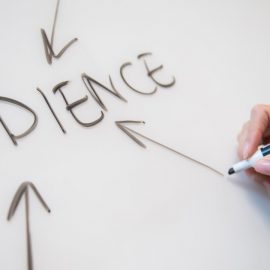

This article is an excerpt from the Shortform book guide to "Talk Like TED" by Carmine Gallo. Shortform has the world's best summaries and analyses of books you should be reading.
Like this article? Sign up for a free trial here .
What makes a good speech delivery? What can you do to deliver your speech in the most impactful and persuasive way possible?
Speech delivery is how you say the words you’ve prepared. It involves many factors, such as how loudly you speak, the pitch of your speech, and how often you pause between points.
Here is how to improve your speech delivery, according to Carmine Gallo.
What Is Speech Delivery?
As the name suggests, speech delivery is how you deliver your speech: your tone, your pace, your body language, your demeanor. However, Gallo focuses on the one element of speech delivery that he believes is crucial to success: the speed of your speech. Speak too quickly, and people will struggle to understand what you’re saying. Speak too slowly, and your audience will swiftly become bored.
So, what speed is “just right”? After analyzing many TED talks, Gallo has concluded that the optimal rate of speech when giving a talk is around 190 words per minute. He argues that this is a conversational speed—for instance, the speed of speech you’d adopt if you were talking to a friend about your favorite TV show. Therefore, it’s a rate of speech that seems both natural and authentic.
An Exception to the Rule
There are some exceptions to this 190-words-per-minute rule. For instance, it’s acceptable to vary the speed of your speech to reflect the tone or content of what you’re saying. For example, when photographer Lisa Kristine gave a TED talk on modern slavery in 2012, she slowed down her rate of speech when she made the important point that despite slavery being illegal worldwide, it still exists almost everywhere. Making this point slowly added emphasis and gravitas to Kristine’s words.
Meanwhile, when Dr. Jill Bolte Taylor gave a 2013 TEDxYouth talk on how the brain changes throughout puberty, the rate of her speech delivery increase to 220 words per minute. She decided to speak this quickly to emphasize the swift nature of the brain’s transformation at this time of life.
Confident Body Language
Rehearse holding your body in a way that suggests you’re sure of yourself and your opinions. If you fail to appear confident in your convictions, your audience will trust you and your opinions less. After all, why would they believe or agree with what you’re saying if you don’t seem certain of it yourself?
There are a number of things you can do to exude confidence through body language:
- Stand up straight—don’t slouch.
- Hold your head up high, rather than looking downwards.
- Make frequent eye contact with the audience.
- Resist the urge to fidget—for instance, play with your hair or scratch your nose.
If you’re not sure which of these confident actions you’re taking already and which you aren’t, video yourself making a speech. Then, watch the video and identify where your problem areas lie.
Fake It ‘Till You Make It
If you’re already feeling confident about your speech delivery, confident body language will likely come naturally. However, if you’re feeling nervous or insecure, you may doubt your ability to hold your body in a way that’s contradictory to your emotions.
If you’re in the latter situation, don’t be afraid to “fake it ‘till you make it.” In other words, keep practicing confident body language no matter how insecure you actually feel. Studies have shown that doing so can actually make you feel more confident. Standing in a confident position increases your levels of testosterone —a hormone which, amongst other functions, increases your confidence—while simultaneously reducing levels of the stress hormone cortisol.
Researchers claim the so-called “power pose” is particularly effective at boosting confidence levels. This involves stretching your arms as wide as possible for two minutes.
Don’t Be Boring
As well as ensuring that your body language is confident, you also need to make sure that it’s not too boring. A common mistake that speakers make is staying still and rooted to the same spot for the entirety of their presentation. Such rigidity will make you seem dull and unenthusiastic about your topic. Instead, continually walk around your presentation space or stage, moving from one end to the other. Your constant movement will keep your audience engaged and make you seem more dynamic.
Hand Gestures
As you speak, don’t simply hide your hands in your pockets. Instead, use gestures to add emphasis to what you’re saying. For example, if you’re talking about how much a problem has grown in size, create a small circle with your hands and expand it. If you want to emphasize that you’ve personally experienced this problem, point at yourself.
Using hand gestures has a number of benefits:
- It prevents you from using your hands to fidget, thus helping you to exude confidence.
- Movement of any kind—including hand movement—makes you more interesting to watch, and therefore grips your audience’s attention.
- Studies have shown that making hand gestures will increase the audience’s confidence in you and what you’re saying.
Four Tips for Using Hand Gestures
Tip #1: Don’t use gestures too often. They’ll lose their impact and may become overly distracting. Only use gestures to punctuate crucial points of your presentation—for example, your main argument, or the conclusion of a story you’re telling.
Tip #2: Only use gestures that feel comfortable and natural to you. In particular, don’t try to mimic another person’s gesturing style—for example, that of a politician or famous speaker—if it’s out of your comfort zone. The gestures will seem forced and you’ll seem inauthentic.
Tip 3: Don’t overthink which gestures to use. Settle on those that feel the most natural and appropriate to the situation.
Tip #4: Keep your gestures within the “power sphere.” This is the area of the body from the eyes down to the navel. Placing your hands any lower than the navel suggests a lack of confidence and energy.
The ‘Eager Nonverbal’ Strategy
If you’re struggling to come up with appropriate hand gestures to use in your speech or presentation, consider applying the ‘eager nonverbal’ strategy. This is a three-pronged strategy that involves:
- Using hand movements that are expansive and animated: for example, opening your arms wide with your palms open.
- Using hand movements that project outward, towards the audience: for example, pointing in their direction.
- Leaning your body forward, again towards the audience.
Research has shown that using the eager nonverbal strategy can persuade others to act in the way you desire. For example, in one study, shoppers were more likely to buy candy from salespeople who implemented this strategy than from those who didn’t. In the case of a presentation, using the eager nonverbal strategy may help you to persuade your audience to adopt your idea or agree with your point of view.
Remember: As noted in the tips above, you should only implement someone else’s gesturing strategy—including the eager nonverbal strategy—if it feels natural and comfortable for you.

———End of Preview———
Like what you just read? Read the rest of the world's best book summary and analysis of Carmine Gallo's "Talk Like TED" at Shortform .
Here's what you'll find in our full Talk Like TED summary :
- The 9 key principles to good public speaking
- How to apply the public speaking strategies of popular TED talks
- How storytelling enhances your appeal to audiences






